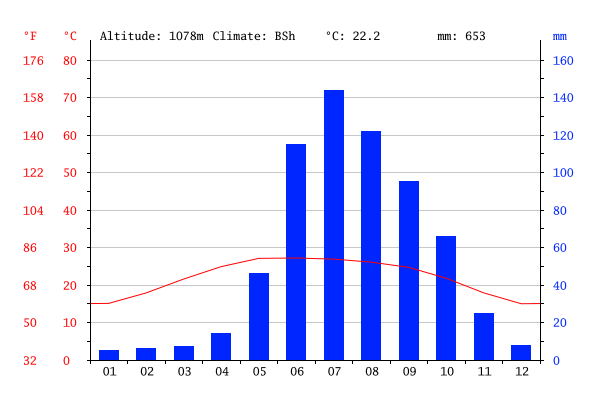
Generally speaking, Yunnan enjoys a mild climate with pleasant weather but, due to its varied terrain, the weather is also diverse in different regions.
Yunnan has high mountains bordering Tibet in the west, a hilly 1,000-m-altitude plateau in the east, and a tropical zone in the south.
Owing to its 1,000-meter-altitude with abundant heat and light, the east of Yunnan (around Kunming) has a year-round spring-like climate. The average temperature annually is 17°C. The coldest month is January with average temperatures ranging from 8°C to 17°C. The hottest month is July with average temperatures ranging from 21°C to 27°C.

Yunnan temperature and precipitation
Yunnan has distinct dry and rainy seasons. November to the following April is the dry season, when there is abundant sunshine and solar radiation is quite strong. Do not forget to take skin care products, such as sunblock and sunglasses if traveling during this period.
The rainy season runs from May to October. Most of the rainfall is between June and August. During this season, the temperature may drop quickly along with the rain. So, apart from an umbrella or other protective rain gear, you are recommended to take a thin overcoat and long pants.
East Yunnan has little temperature difference between seasons but a large temperature difference between daytime and nighttime, especially from November to the following February. Therefore, you are recommended to take a coat or some thicker clothing whenever you travel to Yunnan
Generally speaking, the weather in most areas of Yunnan is mild in winter and cool in summer. It is suitable to visit Yunnan all year round.
As mentioned, Yunnan's varied terrain results in the diversity of its landscapes and weather. The time to go depends largely on what you want to see and which part you want to go to.
Summer (June to September) and fall (October to November) are the most favorable seasons if you do not want to experience the large temperature difference between daytime and nighttime in spring (March to May) and winter (December to February).
Spring and early summer are the best times to see the flora and fauna. Fall and winter are the best times to see snow-capped mountains and peaks.
If you had to pick a single province in China that would expose you to the greatest variations in topography and climate, it would have to be Yunnan Province.
You will only receive emails that you permitted upon submission and your email address will never be shared with any third parties without your express permission.
